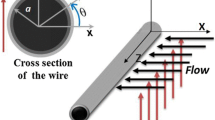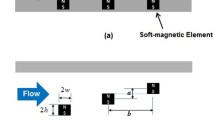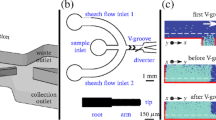Abstract
The ability to trap, manipulate, and separate magnetic beads has become one of the key requirements in realizing an integrated magnetic lab-on-chip biosensing system. In this article, we present the design and fabrication of an integrated magneto-fluidic device for sorting magnetic particles with a sorting efficiency of up to 95%. The actuation and manipulation of magnetic beads are realized using microfabricated square meandering current-carrying micro striplines. The current is alternated between two neighboring micro striplines to switch the magnetic beads to either one of the two outlets. We performed a series of parametric study to investigate the effect of applied current, flow rate, and switching frequency on the sorting efficiency. Experimental results reveal that the sorting efficiency is proportional to the square of current applied to the stripline, and decreases with increasing buffer flow rate and switching frequency. Such phenomena agree well with our theoretical analysis and simulation result. The fastest switching rate, which is limited by the microchannel geometry and bead velocity, is 2 Hz.






Similar content being viewed by others
References
Bange A, Halsall HB, Heineman WR (2005) Microfluidic immunosensor systems. Biosens Bioelectron 20:2488–2503
Bashir R (2004) Biomems: state-of-the-art in detection, opportunities and prospects. Adv Drug Delivery Rev 56:1565–1586
Beyzavi A, Nguyen NT (2008) Modeling and optimization of planar microcoils. J Micromech Microeng 18:095,018
Choi JW, Liakopoulos TM, Ahn CH (2001) An on-chip magnetic bead separator using spiral electromagnets with semi-encapsulated permalloy. Biosens Bioelectron 16:409–416
Choi JW, Oh KW, Thomas JH, Heineman WR, Halshall HB, Nevin JH, Helmicki AJ, Henderson HT, Ahn CH (2002) An integrated microfluidic biochemical detection system for protein analysis with magnetic bead-based sampling capabilities. Lab Chip 2:27–30
Deng T, Prentiss M, Whitesides GM (2002) Fabrication of magnetic microfiltration systems using soft lithography. Appl Phys Lett 80:461–463
Gijs MAM (2004) Magnetic bead handling on-chip: new opportunities for analytical applications. Microfluid Nanofluid 1:22–40
Gijs MAM, Lacharme F, Lehmann U (2010) Microfluidic applications of magnetic particles for biological analysis and catalysis. Chem Rev 110:1518–1563
Huh D, Bahng JH, Ling Y, Wei HH, Kripfgans OD, Fowlkes JB, Grotberg JB, Takayama S (2007) Gravity-driven microfluidic particle sorting device with hydrodynamic separation amplification. Anal Chem 79:1369–1376
Inglis DW, Riehn R, Austin R, Strum J (2004) Continuous microfluidic immunomagnetic cell separation. Appl Phys Lett 85:5093–5095
Jiang Z, Llandro J, Mitrelias T, Bland JAC (2006) An integrated microfluidic cell for detection, manipulation, and sorting of single micron-sized magnetic beads. J Appl Phys 99:08S105
Kim DH, Rozhkova EA, Ulasov IV, Bader SD, Rajh T, Lesniak MS, Novosad V (2010) Biofunctionalized magnetic-vortex microdiscs for targeted cancer-cell destruction. Nat Mater 9:165–171
Kose AR, Fischer B, Mao L, Koser H (2009) Label-free cellular manipulation and sorting via biocompatible ferrofluids. Proc Natl Acad Sci USA 106:21,478–21,483
Lee C, Lee H, Westervelt RM (2001) Microelectromagnets for the control of magnetic nanoparticles. Appl Phys Lett 79:3308–3310
Lee H, Purdon AM, Chu V, Westervelt RM (2004) Controlled assembly of magnetic nanoparticles from magnetotactic bacteria using microelectromagnets array. Nano Lett 4:995–998
Lee H, Liu Y, Ham D, Westervelt RM (2007) Integrated cell manipulation systemcmos/microfluidic hybrid. Lab Chip 7:331–337
Lee WC, Lien KY, Lee GB, Lei HY (2008) An integrated microfluidic system using magnetic beads for virus detection. Diagn Microbiol Infect Dis 60:51–58
Li D, Daghighi Y (2010) Eccentric electrophoretic motion of a rectangular particle in a rectangular microchannel. J Colloid Interface Sci 342:638–642
Lim C, Zhang Y (2007) Bead-based microfluidic immunoassays: the next generation. Biosens Bioelectron 22:1197–1204
Liu C, Lagae L, Wirix-Speetjens R, Borghs G (2007a) On-chip separation of magnetic particles with different magnetophoretic mobilities. J Appl Phys 101:024,913
Liu YJ, Guo SS, Zhang ZL, Huang WH, Baigl D, Xie M, Pang YCDW (2007b) A micropillar-integrated smart microfluidic device for specific capture and sorting of cells. Electrophoresis 28:4713–4722
Nguyen NT, Ng KM, Huang X (2006) Manipulation of ferrofluid droplets using planar coils. Appl Phys Lett 89:052,509
Pamme N (2005) Magnetism and microfluidics. Lab Chip 6:24–38
Pamme N, Wilhelm C (2006) Continuous sorting of magnetic cells via on-chip free-flow magnetophoresis. Lab Chip 6:974C980
Ramadan Q, Samper V, Poenar D, Yu C (2004) On-chip micro-electromagnets for magnetic-based bio-molecules separation. J Magn Magn Mater 281:150C172
Ramadan Q, Samper V, Poenar DP, Yu C (2006) An integrated microfluidic platform for magnetic microbeads separation and confinement. Biosens Bioelectron 21:1693–1702
Rida A, Fernandez V, Gijs MAM (2003) Long-range transport of magnetic microbeads using simple planar coils placed in a uniform magnetostatic field. Appl Phys Lett 83:2396–2398
Rong R, Choi JW, Ahn CH (2006) An on-chip magnetic bead separator for biocell sorting. J Micromech Microeng 16:2783–2790
Shevkoplyas SS, Siegel AC, Westervelt RM, Prentiss MG, Whitesides GM (2007) The force acting on a superparamagnetic bead due to an applied magnetic field. Lab Chip 7:1294–1302
Shikida M, Koyama M, Nagao N, Imai R, Honda H, Okochi M, Tsuchiya H, Sato K (2009) Agitation of magnetic beads by multi-layered flat coils. Sens Actuators B 137:774–780
Smistrup K, Tang PT, Hansen O, Hansen MF (2006) Microelectromagnet for magnetic manipulation in lab-on-chip systems. J Magn Magn Mater 300:418–426
Song SH, Lee HL, Min YH, Jung HI (2009) Electromagnetic microfluidic cell labeling device using on-chip microelectromagnet and multi-layered channels. Sens Actuators B 141:210–216
Speetjens RW, de Boeck J (2004) On-chip magnetic particle transport by alternating magnetic field gradients. IEEE Trans Magn 40:1944–1946
Wang ZH, Lew WS, Bland JAC (2006) Manipulation of superparamagnetic beads using on-chip current lines placed on a ferrite magnet. J Appl Phys 99:08P104
Acknowledgments
This study was supported by the Singapore’s Agency for Science, Technology and Research (A*STAR SERC grant: 082 101 0015) and the Singapore-French MERLION programmes. The authors would also like to acknowledge Mr. Chun Fan Goh for the helpful discussion on image processing and electronic circuit.
Author information
Authors and Affiliations
Corresponding author
Appendices
Appendix 1: Magnetic forces generated by square meandering micro stripline
In order to have a better understanding of the magnetic field strength and the magnetic forces acting on magnetic beads, we utilized the 3-D magnetostatics toolbox in COMSOL multiphysics (COMSOL Inc, USA) to simulate the magnetic field distribution of the micro stripline. Figure 7 shows the COMSOL multiphysics simulation results for the magnetic flux density (a) B x , (b) B y , and (c) B z with an applied current of 2 A and at a height of 10 µm from the copper stripline surface. The stripline has a width of 50 µm and the height-width ratio is 3. The current is set to flow in the left to right configuration. The highest magnetic flux density for the x-, y-, and z-component is approximately 18 mT. In the simulation, we made the following assumptions: the magnetic field is only generated by the current applied to the stripline, the magnetic field is measured in free-space, the current flow is steady, and the magnetic field is not permeating the air box surface. The boundary conditions of the encapsulating box were set to magnetic insulation and electric insulation while the boundary condition of the stripline was set to continuity.
Contour plot of the a x-, b y-, and c z-component magnetic flux density at an applied current of 2 A and at a vertical distance of 10 μm from the stripline. The width of the square meandering micro stripline is 50 µm and its height–width ratio is 3. The maximum magnetic flux density generated with 2 A current is approximately 18 mT
Magnetic beads are attracted to the magnetic field generated by the current-carrying micro stripline. The magnetic force acting on a magnetic bead is governed by (Pamme 2005; Shevkoplyas et al. 2007; Beyzavi and Nguyen 2008):
where
V is the volume of the magnetic bead, \(\Updelta \chi\) is the difference in magnetic susceptibilities between the magnetic particle and its surrounding buffer, B is the magnetic flux density, and μ0 is the magnetic constant \(4\pi \times 10^{-7}\, \hbox{T\,mA}^{-1}.\) After obtaining the magnetic flux density from COMSOL, we can compute the force acting on a magnetic bead using Eq. 14–16. The partial derivative of B x , B y , and B z in the x-, y- and z-direction can be computed using the matrix operation as follows:
where A represents B x , B y , and B z , k is the index representing the kth simulation plane in the z-axis and
Figure 8 shows the simulation results for the variation of the maximum y-component of \(({\mathbf{B}} \cdot {\varvec{\nabla}}){\mathbf{B}},\) which is proportional to the magnetic bead force in the y-direction, F y , with the applied current at a vertical distance of 5, 10, and 15 µm from the stripline surface. From the figure, we can deduce that the maximum y-component magnetic force is proportional to the square of the applied stripline current. The magnetic bead forces decreases with height from the stripline surface. The simulation results for the maximum magnetic forces of x- and z-components also show similar variation trend with the applied current (not shown).
Simulation results for the effect of applied current on the maximum y-component of \(({\mathbf{B}} \cdot {\varvec{\nabla}}){\mathbf{B}},\) which is proportional to the magnetic bead force in the y-direction, F y , at a vertical distance of 5, 10, and 15 µm from the stripline surface. The maximum y-component magnetic force increases with the square of the applied stripline current. Further from the stripline surface, the magnetic forces on the magnetic beads are weaker. The inset is a schematic illustration of the striplines configuration in the microfluidic sorting chamber
Appendix 2: Gravitational settling and wall effect
The magnetic beads tend to sink to the bottom of the channel surface due to the density difference and gravity effect (Li and Daghighi 2010). The sediment velocity of a particle is given by (Huh et al. 2007):
where r is the radius of particles, g is gravitational acceleration, \(\Updelta \rho\) is the density difference between particle and carrier liquid, and μ is the viscosity of buffer. With the diameter of 8 µm and density of the magnetic beads is \(1.07 \,\hbox{g\;cm}^{-3},\) and carrier liquid density of \(1.126 \,\hbox{g\;cm}^{-3}\) and viscosity of 9.01 × 10−3 Pa s, the sedimentation velocity is \(2.17 \times 10^{-7} {\hbox {ms}}^{-1}.\) Without the presence of the magnetic force, the time taken for a bead to sink to the bottom surface for a 25 µm high channel is about 115 s. Since the lowest flow rate used in the experiment is 200 µl h−1, the slowest average time taken for a particle to travel past the sorting chamber of length 3,500 µm approximately 1.6 s. Hence, the gravitational settling effect is negligible.
In addition, due to the low channel height to bead diameter ratio, there bound to be increased hydrodynamic drag force caused by the wall effect in the vertical direction. However, the wall effect is insignificant in the lateral direction (x − y plane) since the width and length of the sorting chamber are 1,000 and 3,500 µm, respectively, while the bead diameter is only 8 µm. The success rate of sorting the beads to the desired outlet depends on the ability of the device to attract the beads in the y-direction. Therefore, the wall effect on the hydrodynamic force is not considered in this study.
Rights and permissions
About this article
Cite this article
Kong, T.F., E, H.S., Sugiarto, H.S. et al. An efficient microfluidic sorter: implementation of double meandering micro striplines for magnetic particles switching. Microfluid Nanofluid 10, 1069–1078 (2011). https://doi.org/10.1007/s10404-010-0735-8
Received:
Accepted:
Published:
Issue Date:
DOI: https://doi.org/10.1007/s10404-010-0735-8






